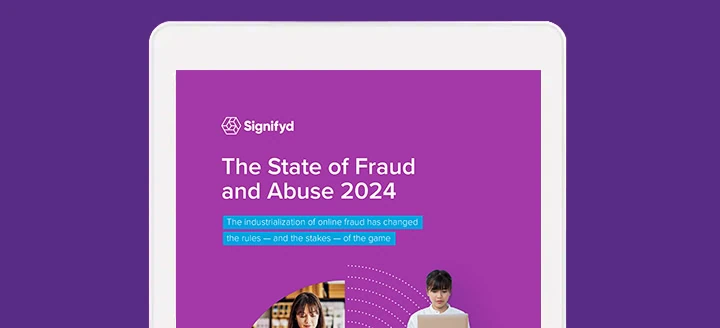As an ecommerce merchant, few things disrupt operations and cut into profits like chargebacks. A chargeback happens when a customer disputes a credit card charge with their issuing bank. The bank then reverses the transaction amount and refunds the customer. While the original purpose of the chargeback process was to protect consumers against credit card fraud, customers looking to get free merchandise or services have started to abuse the privilege through a process sometimes called friendly fraud.”
Reviewed, revised and approved by Signifyd humans.
The impact exceeds just the dollar amount reversed. Each chargeback results in fees from payment processors and card networks like Visa and Mastercard. Administrative costs to respond to disputes along with potential merchandise and shipping costs for unrecoverable items inflate total losses. One study found merchants lose an average $3.75 for every $1 in chargebacks. Every merchant faces this risk to the bottom line.
Dangers extend beyond monetary losses. An excessive chargeback rate damages reputations with banks and processors. This leads to holding funds, higher fees, potential account closures or sanctions such as placement on the Terminated Merchant File. Card networks monitor chargeback ratios and can place merchants in monitoring programs such as the Visa Dispute Monitoring Program (VDMP) when chargebacks cross thresholds.
While chargebacks may never fully be eliminated, merchants can take proactive steps to prevent and mitigate most invalid disputes. The steps merchants can take include understanding the main triggers for chargebacks, utilizing prevention tools, optimizing policies and operations and fighting fraudulent chargebacks.
Understanding the main triggers of chargebacks
There are several reasons why chargebacks occur. Here is a look at the common ones.
Fraudulent transactions
Chargeback fraud comes in several forms. Some fraudulent chargebacks result from outright criminal fraud using stolen credit cards. But “friendly fraud,” also known as first-party fraud, by customers deliberately claiming they didn’t participate in a purchase to get merchandise, goods or services for free is also common.
Product issues
When customers claim they never received the product ordered, it arrived damaged or defective, or it was not as described on the website, they may file a chargeback.
Processing errors/descriptor issues
If the merchant’s name on the credit card statement is unrecognizable or unclear, customers may claim not to recognize the charge and dispute it.
Subscription issues
Customers sometimes dispute recurring subscription charges after an initial free trial if they didn’t intend to purchase or thought they properly canceled. They may also file a dispute explaining that they wanted to cancel a subscription but were unable to.
To reduce chargebacks, merchants must understand the main triggers behind them and implement prevention tactics. Simply writing off chargebacks as a “cost of doing business” leaves significant revenue on the table.
Preventing chargebacks
Have clear return/refund policies and make them visible
Customers are more likely to go through proper refund channels instead of disputing a charge if return policies are clear and easy to find on the website, receipts, etc. Make the process simple to reduce your risk of chargebacks.
Provide excellent customer service
Be responsive when customers have questions or issues. Offer easy ways to contact support, like phone, email, chat and social media. The harder customers must work to reach you, the more likely they are to dispute charges.
Optimize billing descriptors
Use a recognizable business name or website URL in the descriptor on credit card statements. Test to ensure customers see an identifiable name. Unclear descriptors lead to disputes.
Use purchase verification
Require address verification (AVS), CVV codes and other authentication tools to prove customers are authorized users before accepting orders. This deters credit card fraud upfront.
Stay compliant with all payment network rules
Be aware of the time-consuming overall chargeback process. Violations like processing incorrect product codes or delayed transactions can trigger chargebacks. Carefully follow Visa, Mastercard, etc. operating regulations.
Following best practices gives customers fewer reasons to dispute charges and makes operations more chargeback-resistant. But specific prevention tools are also needed.
Chargeback prevention tools & services
Chargeback prevention
Prevention begins with order approvals. A merchant who approves every order is bound to get chargebacks. One who blocks every order with any level of risk will end up with “false positives” and reject lots of good orders. Merchants can conduct manual review to try to prevent bad orders, but this creates a delay for the customer and a headache and high costs for the merchant.
Effective fraud prevention built into the order process helps reduce the risk of chargebacks. Vendors are available who provide manual review and/or automated review using machine learning, or some combination that works for their business. And if the vendor offering chargeback protection also guarantees orders and provides liability shift, merchants don’t need to worry as much about the financial impact of chargebacks.
Chargeback alerts
Chargeback alert services provide advance warning of potential disputes from participating banks, giving merchants 24-72 hours to resolve issues and avoid chargebacks.
Network inquiry tools
These tools connect merchants directly to card networks and issuers to share order details and transaction evidence to resolve potential disputes before chargebacks occur.
Advanced chargeback representment services
Companies like Signifyd help merchants recover losses from chargebacks by resubmitting cases with compelling evidence to get illegitimate chargebacks reversed and funds returned. They handle the entire time-consuming representment process, making sure all deadlines are met and all recovery steps are completed for the merchant. Some will guarantee that chargebacks from approved orders are covered and reimbursed to the merchant.
Chargeback monitoring/management
Chargeback monitoring, analysis tools and prevention advice to help keep chargeback rates under control are available from vendors offering chargeback protection like Signifyd. Some merchants may have access to similar services through their acquiring banks. Acquirers may also receive notifications from Visa or other payment processors when a merchant’s chargeback rates get too high.
Ecommerce merchants cannot rely on manual efforts alone to detect and prevent chargebacks in real time. Automated prevention tools that integrate with operations are essential to a comprehensive strategy. Merchants will also want to be ready for the most common chargeback scenarios.
Handling specific chargeback scenarios
Fraudulent transactions
Leverage fraud detection and fraud prevention tools to stop criminal fraud chargebacks. For friendly fraud, have a robust process to contest invalid disputes with compelling evidence the customer participated in the sale.
Product/service disputes
If customers claim non-delivery, provide tracking numbers and delivery confirmation. For claims of receiving wrong/defective items, have a process to obtain and submit evidence.
Billing descriptor issues
Optimize billing descriptors as covered earlier. Also, send purchase receipts immediately after orders to remind customers what they bought.
Subscription disputes
Improve subscription processes with clear disclaimers about recurring charges and easy cancellation flows. Obtain customer consent and send timely renewal reminders.
While prevention is ideal, the risk of chargebacks will still be present even with excellent practices. Having defined procedures to gather evidence and respond based on the dispute reason code increases the chances of resolving cases successfully.
Advanced chargeback management tactics
With the common scenarios and tools in mind, consider the following tactics in your chargeback prevention strategy.
Understand chargeback reason codes and respond appropriately
Different chargeback reason codes like “product not received” or “canceled recurring transaction” require providing specific evidence. Having a system to automatically take the right response saves time.
Dispute invalid chargebacks through representment
Don’t simply accept all chargebacks. Consistently resubmitting winnable cases with compelling evidence can recover revenue, deter future friendly fraud and protect your financial reputation.
Track key metrics like chargeback ratios and fees
Monitor chargeback rates, total chargeback fees paid and other metrics over time. Set maximum thresholds to trigger improved processes if exceeded.
When to consider chargeback liability shift or reserves
For some larger merchants, having a reserve with funds to cover potential disputes can make sense financially. Merchants of any size might do better to work with a reputable fraud protection vendor providing liability shift, an insurance-like approach to covering losses from chargebacks. The vendor guarantees that any chargebacks that arise from approved orders are covered, shifting liability from the merchant to the vendor.
Just preventing chargebacks upfront is not enough. An advanced strategy also requires monitoring key performance indicators, efficiently resolving disputes when they occur and evaluating revenue protection options.
You can prevent chargebacks
Chargebacks remain a significant source of revenue loss and operational disruption for ecommerce merchants. But they don’t have to be an unavoidable cost of doing business.
By understanding the main triggers like credit card fraud, product issues, processing errors and subscription mishaps, merchants can implement prevention best practices and tools customized to their risks. Making policies clear, prioritizing customer service, optimizing billing descriptors and leveraging services like chargeback alerts and inquiry tools equip merchants to stop many chargebacks before they happen.
When disputes do occur, having defined procedures to provide the right compelling evidence based on reason codes, disputing illegitimate chargebacks through representment and tracking performance metrics allows merchants to resolve chargebacks efficiently and identify areas to improve.
Merchants should also evaluate options like liability shift or chargeback reserves based on their specific risk profile. With a comprehensive prevention and chargeback management strategy in place, merchants can minimize chargebacks, recover more revenue, maintain processing capabilities and preserve customer relationships.
Implementing the strategies in this guide requires an investment of time and resources. But the ROI of a chargeback prevention plan makes it worthwhile for any merchant wanting to eliminate this significant, unpredictable revenue drain.












